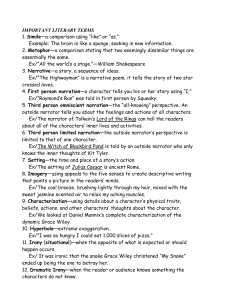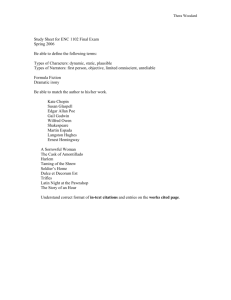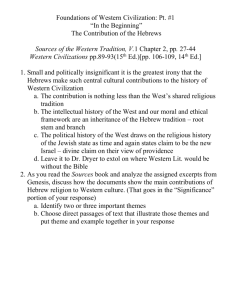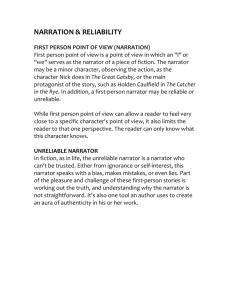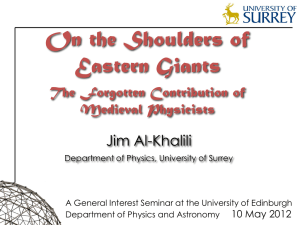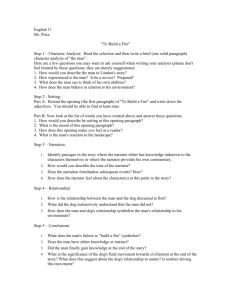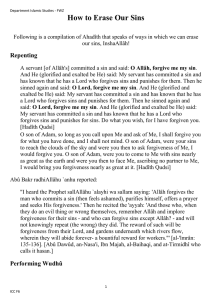Class notes
advertisement
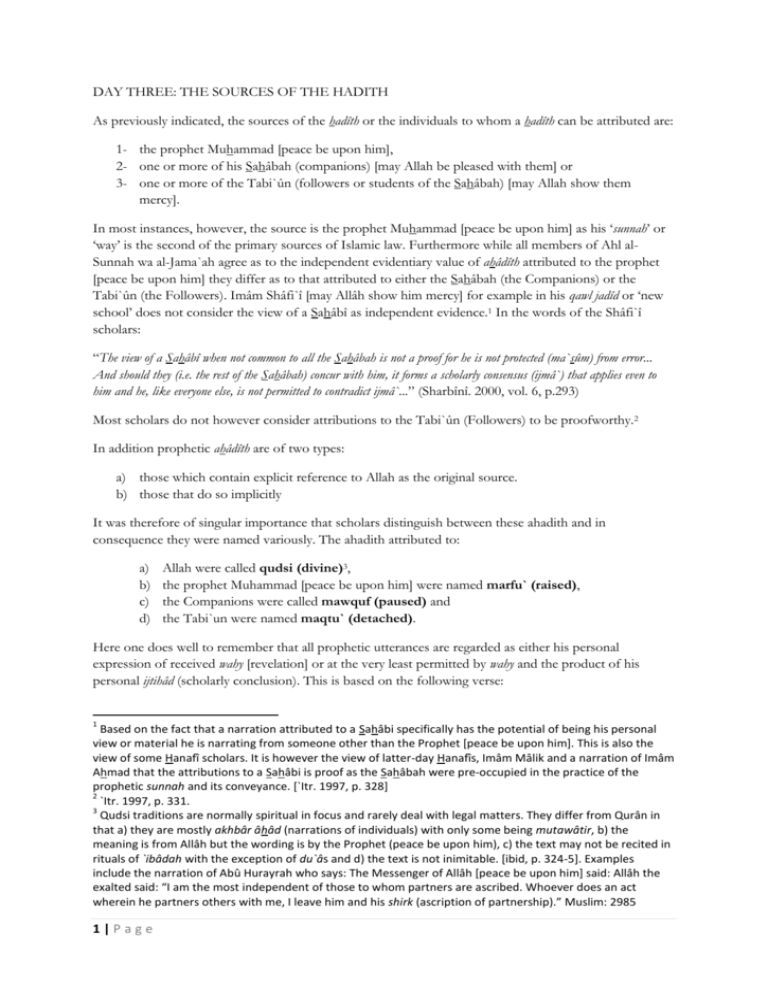
DAY THREE: THE SOURCES OF THE HADITH As previously indicated, the sources of the hadîth or the individuals to whom a hadîth can be attributed are: 1- the prophet Muhammad [peace be upon him], 2- one or more of his Sahâbah (companions) [may Allah be pleased with them] or 3- one or more of the Tabi`ûn (followers or students of the Sahâbah) [may Allah show them mercy]. In most instances, however, the source is the prophet Muhammad [peace be upon him] as his „sunnah‟ or „way‟ is the second of the primary sources of Islamic law. Furthermore while all members of Ahl alSunnah wa al-Jama`ah agree as to the independent evidentiary value of ahâdîth attributed to the prophet [peace be upon him] they differ as to that attributed to either the Sahâbah (the Companions) or the Tabi`ûn (the Followers). Imâm Shâfi`î [may Allâh show him mercy] for example in his qawl jadîd or „new school‟ does not consider the view of a Sahâbî as independent evidence.1 In the words of the Shâfi`î scholars: “The view of a Sahâbî when not common to all the Sahâbah is not a proof for he is not protected (ma`sûm) from error... And should they (i.e. the rest of the Sahâbah) concur with him, it forms a scholarly consensus (ijmâ`) that applies even to him and he, like everyone else, is not permitted to contradict ijmâ`...” (Sharbînî. 2000, vol. 6, p.293) Most scholars do not however consider attributions to the Tabi`ûn (Followers) to be proofworthy.2 In addition prophetic ahâdîth are of two types: a) those which contain explicit reference to Allah as the original source. b) those that do so implicitly It was therefore of singular importance that scholars distinguish between these ahadith and in consequence they were named variously. The ahadith attributed to: a) b) c) d) Allah were called qudsi (divine)3, the prophet Muhammad [peace be upon him] were named marfu` (raised), the Companions were called mawquf (paused) and the Tabi`un were named maqtu` (detached). Here one does well to remember that all prophetic utterances are regarded as either his personal expression of received wahy [revelation] or at the very least permitted by wahy and the product of his personal ijtihâd (scholarly conclusion). This is based on the following verse: 1 Based on the fact that a narration attributed to a Sahâbi specifically has the potential of being his personal view or material he is narrating from someone other than the Prophet [peace be upon him]. This is also the view of some Hanafî scholars. It is however the view of latter-day Hanafîs, Imâm Mâlik and a narration of Imâm Ahmad that the attributions to a Sahâbi is proof as the Sahâbah were pre-occupied in the practice of the prophetic sunnah and its conveyance. [`Itr. 1997, p. 328] 2 `Itr. 1997, p. 331. 3 Qudsi traditions are normally spiritual in focus and rarely deal with legal matters. They differ from Qurân in that a) they are mostly akhbâr âhâd (narrations of individuals) with only some being mutawâtir, b) the meaning is from Allâh but the wording is by the Prophet (peace be upon him), c) the text may not be recited in rituals of `ibâdah with the exception of du`âs and d) the text is not inimitable. [ibid, p. 324-5]. Examples include the narration of Abû Hurayrah who says: The Messenger of Allâh [peace be upon him] said: Allâh the exalted said: “I am the most independent of those to whom partners are ascribed. Whoever does an act wherein he partners others with me, I leave him and his shirk (ascription of partnership).” Muslim: 2985 1|Page “He speaks not of his own whim. It is no more than revelation being sent down.” Najm: 3-4 Nonetheless ahâdîth originally termed mawqûf or „attributed to a Sahâbi‟ are upgraded to the rank of marfû` or „attributed to the prophet Muhammad [peace be upon him]‟ when they successfully meet any of the following criteria: 1- When the import of the hadîth cannot possibly be the product of personal opinion (ra’y) or legal analogy (qiyâs) such as with mawâqît (time-periods), maqâdîr shar`iyyah (legal amounts), ahwâl alâkhirah (conditions of the Hereafter), qisas al-mâdîn (stories of past generations) and asbâb al-nuzûl (occasions of revelation). An example of this is the narration of Jâbir who states that: “The Jews used to say that engaging in sexual intercourse from the rear but entering the vagina causes the child to be born squint-eyed. Allâh then revealed the verse: (Your women are a plantation to you.)” Bukhârî: 4528 and Muslim: 1435. 2- The Sahâbi [may Allâh be pleased with him] reports it as of the practises or statements of the Sahâbah especially when attributed to the past tense.4 An example of this is the hadîth of Jâbir “We used to practise `azl [coitus interruptus] (as a contraceptive method) in the prophetic era when Quran was still being revealed (yet never did it or the Prophet forbid us the act).” Narrated by Bukhârî: 5209 and Muslim: 1440. 3- When the Sahâbi [may Allâh be pleased with him] opens the narrative with some statement or the other that indicates it to be marfû`. Examples of this include: a) Anas reports that “Bilâl was commanded to recite the lines of adhân twice and that of the iqâmah once with the exception of the line of iqâmah.” Bukhârî: 605 and Muslim: 378. b) `Imrân ibn Husayn reports “We were prohibited from kayy (cauterization). Tirmidhî: 2049. c) `Alî reports “It is of the sunnah5 to go to the place of `Îd walking and to eat something before you depart.” Tirmidhî: 530. Tirmidhî then comments: “This is a hasan tradition. The practise of this hadîth by most scholars is that one should go to the place of `Îd walking and that one should eat something before one leaves for the salâh of `Îd alFitr.” 4- When at the mention of the Sahâbî [may Allâh be pleased with him] a statement is made that indicates the hadîth to be marfû`. Such statements include a) he states it is marfû` (yarfa`uhu), b) he attributes it (yanmîhi) and c) as a narration (riwâyatan). An example of this is the narration of Abû Hurayrah rafa`ahu (who states it is marfû`): “The molar tooth of the kâfir is similar (in size) to Uhud.” Tirmidhi: 2579 DAY FOUR: NARRATOR COVERAGE OF HADITH Not all ahâdith [sing. hadîth] have been established equally. Some are reported so widely and consistently that it is believed to be free from narrator error – both intentional and inadvertent – and as such is 4 Here there are two possibilities: a) attribution to the prophetic epoch and b) a general ascription to the past. The majority consider attribution to the prophetic epoch to be marfû` while a general ascription is subject to scholarly difference with Imâms Nawawî, Râzî, Amidî and Suyûtî deeming it also marfû`. [`Itr. 1997, p. 329] 5 This is because statements where the Sahâbah are commanded or prohibited must refer to someone whose command and prohibition holds authority and as such can only refer to the Prophet [peace be upon him]. It is the same when the word sunnah is used authoritatively. 2|Page considered conclusively established [qat`î al-thubût]. This type of report is classified as the „mutawatir tradition‟ or the „hadîth mutawâtir‟. Other ahâdîth known as „akhbar ahâd‟ or „the narrations of individuals‟, though not reported as widely yet having received coverage by individual narrators, are considered probable evidence [dalil thannî] when they meet certain criteria. Those that do not meet the criteria are rejected as unauthentic [da`if] and their import is generally considered unproven [ghayr thâbit]. A point worthy of note here is that the mutawâtir tradition is not required to meet the criteria of authenticity to which the khabar wâhid [sing. of akhbâr ahâd] is subjected. It has its own criteria which only either qualifies it as a mutawâtir or not. As such there is no unauthentic mutawâtir tradition. All traditions that qualify as mutawâtir are considered definitive evidence and above reproach as to their authenticity. On the other hand when a hadîth does not qualify, it is merely deemed a khabar wâhid and then subjected to criteria of authenticity. Another distinction between the mutawâtir and akhbar âhâd reports is that since the former is considered definitive evidence and the latter – at best – probable evidence, the applicable ruling on one who rejects either differs. As the import of a mutawâtir tradition is massively corroborated it is considered definitely true. Its denial – should the prophet Muhammad [peace be upon him] be the source – constitutes rejection of the word of a messenger of Allâh which renders the guilty individual an apostate (kâfir murtadd). Here it is a condition that said individual has no valid excuse for being ignorant of the mutawâtir status of the report such as when it concerns a matter invariably known by all to be part of the essential teachings of Islam [ma`lum min al-din bi al-darûrah]. Conversely rejection of the khabar wâhid is denial of probable evidence which, although still a sin, is much lesser in gravity than the former. The guilty party is therefore considered a fâsiq [profligate] only and certainly not a kâfir. Someone that rejects ahâdith in their entirety has inevitably rejected mutawâtir reports and is thus also considered a kâfir. Conversely the individual that accepts all authentic ahâdîth as true yet fails to act on several is considered no more than a fâsiq even in the event that he or she has failed to act on mutâwatir reports. The mutawâtir report is generally defined as: “any report that is narrated by such a large and diverse narrator base in every generation that it is judged impossible by natural law that they could have either contrived to lie or accidently concurred in their individually produced yet textually similar lie.6” Its criteria are: a) b) c) d) that it is narrated by a large and diverse group of people in every narrator-level (tabaqah), that they base their report on sensory perception, such as with eyewitness report, that their veracity in this report be considered definite and not merely probable. that the chain of narration is continuous and unbroken There are various types of mutawâtir reports: 1- mutawâtir lafthî or those that share the same or similar wording such as the prophetic hadîth: “Whosoever lies against me intentionally, let him prepare to take his place in Hellfire.” Narrated by Bukhârî: 110 and Muslim: 3. Apparently more than 70 Sahâbah narrate this hadîth from the Prophet [peace be upn him]. 6 In this context the term ‘lie’ encompasses all statements that do not accord with reality whether its disparity was intentional or not. 3|Page 2- mutawâtir ma`nawî or those that are worded differently yet possessing a common idea such as the lifting of the hands when making du`â. There are apparently more than a hundred traditions which mention this but all on different occasions. See for example Bukhârî: 933. 3- those that are passed by one entire generation of Muslims to the next till present times. The most perfect example of this is the Qurân. 4- those that involve a continuous practise by one generation to the next from the time of the Messenger of Allah [peace be upon him] till present times. An example of this is the wiping of the khuffs which is narrated to be the practise of more than 80 Sahâbah. DAY FIVE: THE NARRATIONS OF INDIVIDUALS [AKHBÂR ÂHÂD] The „sanad‟ or chain of authorities of a particular report is only as strong as its weakest link. Scholars therefore take great pains to identify and rate the weakest point in the sanad. The mutawâtir report, though susceptible to fluctuations in narrator numbers, never dips to below such a large amount of diverse narrators in every narrator-level (tabaqah) that it provides massive corroboration. The possibility of narrator error – both intentional and unintentional – is thereby effectively nullified. Akhbâr âhâd reports on the other hand, already open to the possibility of narrator error suffer huge discrepancies in narrator numbers in the various narrator-levels. Some narrator-levels of the same hadîth can contain such a large number of narrators that, with regards to number specifically, the requirements of the mutawâtir report are satisfied while others can drop to only one narrator per level. In such and similar cases involving differences in the number of narrators per level, the level containing the least amount of narrators – effectively its weakest link – is considered the determining factor as to its classification. This effectively provides four possibilities: 1- Where the lowest amount meets the requirements of the mutawâtir tradition and is therefore classified as such. 2- Where the lowest amount is three or more narrators without fulfilling the requirements of the mutawâtir tradition. Such a hadîth is classified as mash-hûr (famous). 3- Where the lowest amount is two narrators. It is called the `azîz (strong) narration. 4- Where the lowest amount is one narrator. This type of narration is known as the gharîb (isolated) tradition. Some scholars – like al-Hâkim al-Naysâbûrî – apparently required a hadîth to at least be `azîz before it could be considered sahîh. The vast majority of scholars however accept even the gharîb tradition should it meet the requirements of authenticity. Hâkim himself in his Mustadrak goes contrary to his alleged view in that the Mustadrak was compiled with the intention of only including sahîh narrations yet some were found to be gharîb. Akhbâr âhâd reports which meet the requirements of authenticity are graded from highest to lowest as follows: 1234- Sahîh li dhâtihi or highly authentic by itself. Sahîh li ghayrihi or highly authentic due to supporting evidence. Hasan li dhâtihi or of acceptable authenticity by itself. Hasan li ghayrihi or of acceptable authenticity due to supporting evidence. 1) The sahîh li dhâtihi tradition is defined as: “any report which has an unbroken chain of authorities made up of accurate narrators of established integrity and which is found to be free from irregularities and defects.” 4|Page As such the conditions of the sahîh li dhâtihi narration are five: 1- The chain of narrators must be continuous and unbroken [mut-tasil]. A chain is considered unbroken when every narrator in the chain actually received the hadîth from the one that precedes him. The chain becomes broken and discontinued when a narrator fails to mention the actual person he received the hadîth from and narrates it from someone higher up in the chain. Scholars, due to their resultant inability to identify and grade this unknown narrator, consequently reject the hadîth as unsubstantiated. 2- The narrators must all be accurate [dâbit] in their narratives. Narrator accuracy is determined by comparing the narrations of a particular individual with that of his previously verified contemporaries. If his reports concur with theirs in almost all instances – even if only in import and not wording – he is considered a dâbit (highly accurate). If his reports concur for the most part, he is considered khafîf al-dabt (of low but acceptable accuracy). The narrator of the sahîh tradition needs to be highly accurate (dâbit). 3- The narrators must be people of integrity [`adâlah]. Narrators are only considered as possessing integrity when they are Muslim, sane, adult and free from fisq (profligacy) and anything that renders them dishonourable.7 One is guilty of fisq when he commits a kabîrah (major sin) or persists in the commission of saghâ’ir (minor sins)8 by repeating the same minor sin or constantly moving from one minor sin to another. 4- The narration must not prove irregular [shâdh-dh]. A judgment of irregularity is made when the report differs markedly with that of other narrators who are considered higher authorities either due to their greater number or superior narrative abilities. 5- The narration must be free from damaging hidden defects [`ilal qâdihah]. A defect occurs when any of the above four conditions are not fulfilled. When lack of fulfilment is noticeable even to the novice muhaddith (scholar of hadîth), it is considered obvious and when detectable only to expert scholars, it is considered hidden. `Alî ibn al-Madînî [d. 324 AH] for example said that a hidden defect can only be detected by comparing between all the available sanads of a particular hadîth. A damaging defect is one which renders the hadîth unusable in that it brings its authenticity into question or causes its import to be indiscernible. 2) The hasan li dhâtihi tradition is produced when a hadîth fulfils all the conditions of the sahîh narration except that one or more narrators are found to be khafîf al-dabt (of low but acceptable accuracy). 3) The sahîh li ghayrihi tradition is produced when the hasan narration is elevated to the sahîh level by supporting evidence. This is done in two ways: 1- When the same or similar text is also narrated in the sahîh li dhâtihi form. Here the latter sahîh li dhâtihi chain raises the hasan chain to sahîh li ghayrihi. 2- When two hasan chains for the same or similar text are found with two different khafîf al-dabt narrators at the location in the sanad which gives it its hasan status. These two narrations corroborate one another and both are subsequently raised to sahîh li ghayrihi. 7 Dishonourable acts are those which go contrary to sound social practices and indicate that the doer is a careless and inconsiderate individual. Examples of these include urinating on a public pathway and excessive joking such as with serious matters. [`Itr. 1997, p. 80.] Imâm Shâfi`î [may Allâh have mercy on him] is reported to have said to his son `Uthmân: “Had I believed that the drinking of cold water reduces one’s honour, I would have refrained from doing so.” [Subkî. Tabaqât. 2:136 and Hilyah al-Awliyâ’. 9:124-6] 8 For the principle of differentiation between major and minor sins, see `Izz al-Dîn ibn `Abd al-Salâm, Masâlih al-Anâm, vol. 1, p. 19. 5|Page 4) The hasan li ghayrihi tradition is produced when a da`îf (unauthentic) narration, the weakness of which is slight (khafîf), finds substantiation in one of three ways: 1- When the same or similar text is also narrated in the sahîh li dhâtihi form. Here the latter sahîh li dhâtihi chain raises the da`îf chain to hasan. 2- When the same or similar text is also narrated in the hasan li dhâtihi form. Here the latter hasan li dhâtihi chain raises the da`îf chain to hasan. 3- When two da`îf chains – the weakness of which is slight (khafîf) – for the same or similar text are found with two different weak narrators at the location in the sanad which gives it its da`îf status. These two narrations corroborate one another and both are subsequently raised to hasan li ghayrihi. a) An example of a sahih li dhatihi tradition narrated by Bukhârî: 5971 and Muslim: 2548 is: (haddathanâ) Qutaybah ibn Sa`îd (haddathanâ) Jarîr (`an) `Umârah ibn al-Qa`qâ` ibn Shubrumah (`an) Abû Zur`ah (`an) Abû Hurayrah who said: “A man came to the Messenger of Allâh [peace be upon him] who asked: Oh Messenger of Allâh, who is more entitled to my good companionship. He answered: Your mother. The man then asked: Then who (thereafter)? He answered: Your mother. The man then asked: Then who (thereafter)? He answered: Your mother. The man then asked: Then who (thereafter)? He answered: Your father.” Analysis of this tradition: This hadîth is considered sahîh because it is narrated via a continuous chain of authorities composed of accurate narrators of confirmed integrity and is free from irregularity and hidden defects. Bukhârî and Muslim are two of the greatest scholars of hadîth in the history of Islâm. Their teacher Qutaybah is thiqah (reliable) and of great standing. His teacher Jarîr ibn `Abd al-Hamîd is thiqah and accurate via the usage of written material. Some say that in his old age he made mistakes when he narrated from memory but this is not harmful here as Qutaybah is one of his early and senior students. `Umârah and Abû Zur`ah (Ibn `Amr ibn Jarîr ibn `Abd Allâh al-Bajalî) are also ranked as thiqah. Abû Hurayrah [may Allâh be pleased with him] is a Sahâbî and considered the greatest narrator of hadîth amongst the Companions. The text of the hadîth itself accords with other evidences and does not contradict known facts. b) An example of a hasan li dhâtihi tradition narrated by Ibn Mâjah: 215 and Ahmad: 11870 on the authority of Anas ibn Mâlik who says that the Messenger of Allâh [peace be upon him] said: “Verily Allâh has family amongst the people. When asked who they were, he answered: The people of the Qurân are the family of Allâh and His selected group.” Analysis of this tradition: The narrators of this sanad are all thiqah with the exception of `Abd alRahmân ibn Badîl whose has a slight defect in his memory yet is still of acceptable accuracy. Ibn Hajar classes him as “lâ ba’sa bihi” or “not problematic”. As such the hadîth is classed hasan. c) An example of a sahîh li ghayrihi is the tradition narrated by Muslim: 1164 on the authority of Abû Ayyûb al-Ansârî that the Messenger of Allâh [peace be upon him] said: “He who fasts Ramadân and follows it with six (days) of Shawwâl, it is as perpetual fasting.” Analysis of this tradition: The narrators of this hadîth are all thiqah with the exception of Sa`d ibn Sa`îd al-Ansârî who is classed sadûq sayyi al-hifth (truthful but weak of memory) by Ibn Hajar. As such this hadîth is hasan on its own however it is supported by another narration in Musnad Ahmad: 21906 and Ibn Mâjah: 1715 on the authority of Thawbân that the Prophet [peace be upon him] said: “Whosoever fast 6|Page the month of Ramadân, it is one month in exchange for ten months and the fasting of the six days after (`Îd al-)Fitr is the completion of the year.” This hadîth is sahîh and raises the previous hadîth to the level of sahîh li ghayrihi. d) An example of a hasan li ghayrihi is the tradition narrated by Ibn Mâjah: 1520 and Tirmidhî: 1057 on the authority of Ibn `Abbâs [may Allâh be pleased with him] that the Messenger of Allâh [peace be upon him] entered a man into his grave at night and put lamps in his grave. Analysis of this tradition: The narrators of this hadîth are either thiqah or suitable for a hasan tradition with the exception of Minhâl ibn Khalîfah as he is ranked da`îf by scholars of hadîth. As such the hadîth when considered in isolation is unauthentic but not severely so. It however has a supporting hadîth that appears in Abû Dâwud: 3164, the Mustadrak of Hâkim vol. 1 p. 368 and in Bayhaqî vol. 4 p. 53 but it contains the narrator Muhammad ibn Muslim al-Ta‟ifî who is weak of memory. Still the two narrations corroborate one another and the hadîth is raised to hasan li ghayrihi. 7|Page
